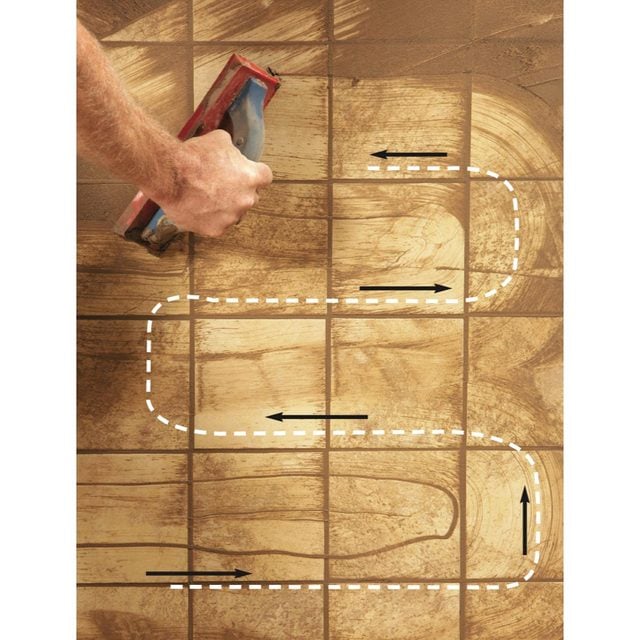Finish your new tile project with a professional quality grout job.
A full day
Beginner
$51–100
Introduction
Master these simple professional grouting skills for durable, good-looking grout lines and a more attractive tiling job.
Tools Required
- Bucket
- Caulk gun
- Grout float
- Margin trowel
- microfiber towel
- Putty knife
- Shop vacuum
- Tiling sponge
- Utility knife
Materials Required
- Caulk
- Grout
- Masking tape
Watch How to Grout Tile: Grouting Tips and Techniques
Project step-by-step (12)
Start with clean joints
Vacuum the grout lines, then scrape any protruding grout using a stiff putty knife and vacuum again. Don’t scrape too hard or you may chip the tile glazing.

Apply tape to trim tiles
For easier cleanup, tape off painted walls to protect them from grout. Also tape off any trim or inset tiles that feature imprinted patterns with crevices.

Mix the grout until it’s powder-free
Mix the grout with a margin trowel until all the powder is dissolved. Roll the bucket frequently while mixing. Scrape the bottom to make sure all the grout is mixed. Pour some grout out of the bag into a mixing bucket. Pour water in a little at a time and start mixing by hand using a margin trowel. Tip the bucket toward you and roll it in a “cement mixer” style as you mix.
When you’re getting close, dribble in water from a sponge. It only takes a little too much to create soup. And don’t mix grout with a drill and mixing paddle. This method churns the grout and introduces air into the mix. That weakens the cured strength and causes a type of discoloration called “shading.” Besides, we’re trying to mix grout here, not make soufflé.

Let the grout “slake”
When your grout has reached peanut butter status, stop! Go and make a sandwich, take out the trash, whatever. Let the grout slake (rest) for about 10 minutes. This allows the chemicals in the grout to work their magic. Skipping this step may result in weaker, crack-prone joints. After slaking, the grout will feel a bit stiffer, but don’t add more water. Remix the grout by hand again to loosen it up.
Load the grout float
Tip the bucket toward you (like you did when mixing) and “drag” some grout with your float up the side of the bucket toward you to start your tile project. This pulls a “working batch” closer to you and makes it easier to scrape up a decent amount of grout onto your float. Push the float tight against the side of the bucket and scrape off a dollop of grout. Any excess that falls off will only fall into the bucket and not off the edge and onto the floor.

Load the joints
Apply the grout diagonally across the tile joints to squish the grout into the joints. Use whichever side or corner of the float is necessary to fully compress grout into the entire joint. On vertical surfaces, apply grout upward. That way you won’t drop so much on the floor.

Clean off excess grout
Remove the bulk of the grout by wiping in a serpentine motion. This helps evenly distribute the grout and prevents the grout float edge from digging into grout lines. After you’ve filled all the joints, make your first “cleanup” passes with the float.

Sponge the surface
Once the grout has started to harden (20 to 30 minutes), begin sponging. Don’t use just any sponge, especially one from the kitchen; choose a “hydrophilic” sponge. Make sure the sponge is damp, not wet, and sweep diagonally across the face of the tile and wipe the grout off the tile surface. On your first few passes, the grout will smear all over the tile and look like a mess — that’s OK. Just rinse out your sponge often in a bucket of clean water (never in the sink) and keep wiping. Rinse your sponge often and repeat until you’re left with a thin haze.

Tool the grout lines
When the surface has been cleaned, begin ‘tooling’ (smoothing and leveling) the grout lines with the sponge. Hold the sponge in your palm and, gently pressing down with your index finger, run the sponge over any grout joints that look too high or uneven. The goal of this step is to produce consistent, even-depth grout joints. Don’t push too hard; let the sponge do the work.

Towel off the haze
After all the joints have been dressed, step away for about a half hour to let the surface dry and form a haze. Then wipe away the haze with a towel. Regular towels work, but microfiber towels are the optimal tool for this task. With more fibers, they remove grout haze much more quickly and cleanly han a regular towel.

Keep some leftover grout
It’s a good idea to hold on to a small quantity of unused grout for future touch-ups as you discover how to grout tile. Grout will easily absorb ambient moisture, so store it in an airtight container such as a resealable plastic bag or a canning jar.

Caulk all inside corners
One place you don’t want to grout is an inside corner. Inside corners that are grouted will always crack over time. Instead, use a color-matching caulk on any inside corners after you’re done grouting and cleaning. Don’t overfill the void; you’ll just make it harder to tool and clean.





















